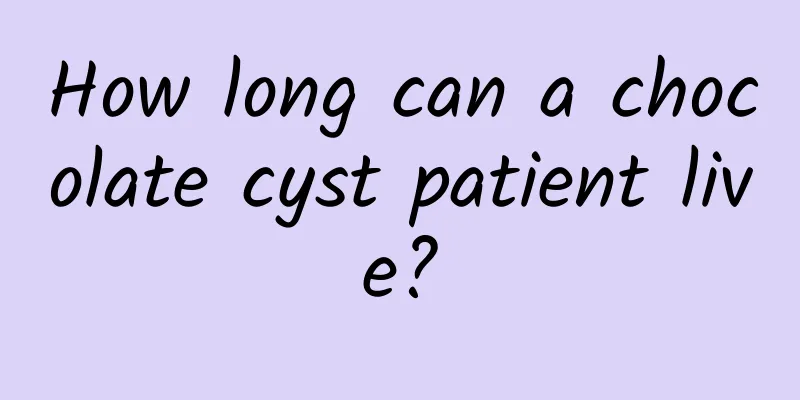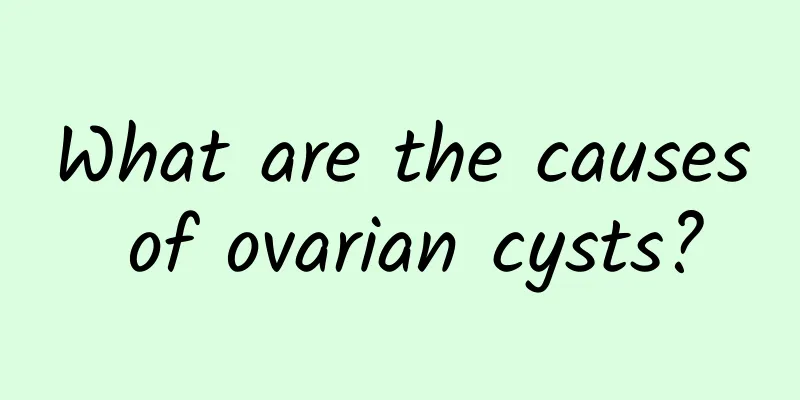How long can a chocolate cyst patient live?

|
How long can patients with chocolate cysts usually live? In fact, this disease will not affect life expectancy. We need to be aware of the harm caused by chocolate cysts to women. Chocolate cysts are one of the most common gynecological ovarian diseases. Only by understanding the harm caused by chocolate cysts to women can we remind everyone to prepare early to avoid the occurrence of disease hazards. The harm of chocolate cyst to women: 1. Generally, ovarian chocolate cysts can rupture spontaneously without any inducement. Rough or intense sexual intercourse, especially premenstrual sexual intercourse, is a common cause of cyst rupture. Moreover, after a period of time, the blood in the chocolate cyst will increase again, and when the pressure increases again, it may rupture spontaneously again. After the cyst ruptures, the blood in the pelvic cavity will irritate the peritoneum, causing severe abdominal pain and adhesion of pelvic organs. 2. Severe ovarian chocolate cysts may cause female infertility. Due to the rupture of ovarian chocolate cysts, what flows into the pelvic cavity is old blood, not a large amount of fresh bleeding. Except for abdominal pain, it usually does not affect vital signs and shock will not occur. Since it is not life-threatening, can conservative treatment without surgery be adopted to save patients from the pain of surgery? In fact, after conservative treatment, the rupture of the cyst wall heals and the symptoms disappear, but spontaneous rupture may occur again soon. Repeated attacks and suffering, and the more attacks, the more severe the pelvic adhesions caused, and the abdominal pain and other symptoms caused by pelvic adhesions. 3. Patients may experience irregular menstruation and sexual pain. Excessive menstrual bleeding is also one of the common clinical symptoms of chocolate cysts. The regularity of the menstrual cycle is characterized by excessive menstrual bleeding or prolonged menstruation. Patients may also experience spotting during sexual intercourse, and it is often more obvious before menstruation. 4. Ovarian chocolate cysts are very easy to rupture, causing abdominal pain, sexual intercourse pain and other symptoms. Of course, for smaller ovarian chocolate cysts, rupture is usually not easy to occur. The drug effect of treating ovarian chocolate cysts is poor, and it is difficult to eliminate chocolate cysts. When the cyst grows to more than 3 cm, the risk of spontaneous rupture begins to appear and gradually increases. When it grows to a certain size, spontaneous rupture is often difficult to avoid. The above is an analysis of the harm caused by chocolate cysts to women. It is understood that chocolate cysts are very harmful to women, especially the ovaries as an important special organ of women. Chocolate cysts have a great impact on the lives of patients. |
<<: How are chocolate cysts transmitted?
>>: Daily care that patients with chocolate cysts should know
Recommend
The hazards of pelvic inflammatory disease mainly include the following situations
Pelvic inflammatory disease is very harmful to wo...
Scientific diet is helpful for relieving women's dysmenorrhea
Dysmenorrhea is very common in our lives. Most wo...
Symptoms caused by ovarian cyst compressing the diaphragm
As ovarian cysts continue to grow and compress th...
What should girls do if they have irregular menstruation? 4 complications of irregular menstruation in girls
What should girls do if they have irregular menst...
What should I do if I feel dizzy and weak due to bleeding during ovulation?
What should I do if I feel dizzy and weak due to ...
The causes of multiple uterine fibroids. Will multiple uterine fibroids become malignant?
Uterine fibroids are common benign tumors in the ...
What are the specific symptoms of ectopic pregnancy?
Among women's gynecological diseases, ectopic...
Should I remove my makeup when exercising? Beautiful Doctor: At least do this first...
Finally off work! Many female office workers who ...
Is pelvic effusion related to the rectum? What are the risk factors?
Is pelvic effusion related to the rectum? What ar...
How to treat irregular menstruation? How to treat irregular menstruation?
Menstruation is something that every woman should...
What are the chances of pregnancy with Bartholinitis?
Nowadays, Bartholinitis has gradually become a co...
What are the examination items for bacterial vaginosis?
Although bacterial vaginosis is a common gynecolo...
Common causes of vulvar leukoplakia
Some people don't know much about the disease...
Red bean water reduces edema and helps with weight loss, female celebrities love it! "These two types" of people drink red bean water to lose weight
Red beans are high in protein, low in fat and hig...
Pay attention to purulent vaginitis!
As the number of patients with vaginitis increase...









